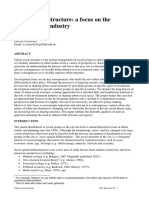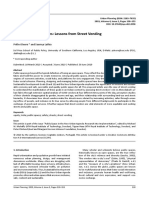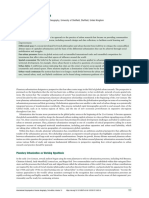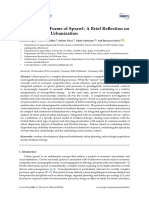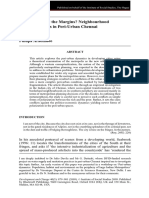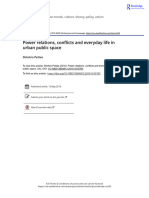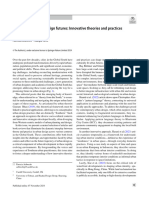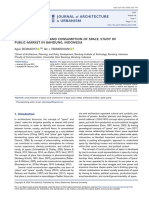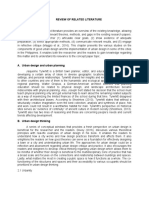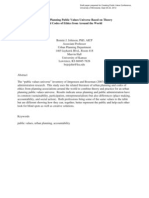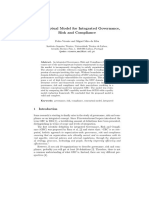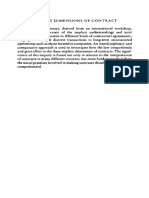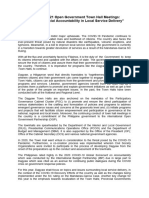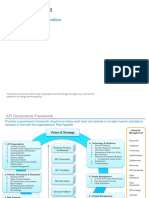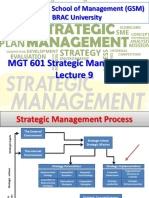Gururani, 2021. Coproduction Periphery
Gururani, 2021. Coproduction Periphery
Uploaded by
francesca.ferliccaCopyright:
Available Formats
Gururani, 2021. Coproduction Periphery
Gururani, 2021. Coproduction Periphery
Uploaded by
francesca.ferliccaCopyright
Available Formats
Share this document
Did you find this document useful?
Is this content inappropriate?
Copyright:
Available Formats
Gururani, 2021. Coproduction Periphery
Gururani, 2021. Coproduction Periphery
Uploaded by
francesca.ferliccaCopyright:
Available Formats
South Asia Multidisciplinary Academic
Journal
26 | 2021
Engaging the Urban from the Periphery
The Co-production of Space, Politics and
Subjectivities in India’s Urban Peripheries
Shubhra Gururani and Loraine Kennedy
Electronic version
URL: https://journals.openedition.org/samaj/7365
DOI: 10.4000/samaj.7365
ISSN: 1960-6060
Publisher
Association pour la recherche sur l'Asie du Sud (ARAS)
Electronic reference
Shubhra Gururani and Loraine Kennedy, “The Co-production of Space, Politics and Subjectivities in
India’s Urban Peripheries”, South Asia Multidisciplinary Academic Journal [Online], 26 | 2021, Online since
03 May 2021, connection on 11 May 2021. URL: http://journals.openedition.org/samaj/7365 ; DOI:
https://doi.org/10.4000/samaj.7365
This text was automatically generated on 11 May 2021.
This work is licensed under a Creative Commons Attribution-NonCommercial-NoDerivatives 4.0
International License.
The Co-production of Space, Politics and Subjectivities in India’s Urban Peri... 1
The Co-production of Space, Politics
and Subjectivities in India’s Urban
Peripheries
Shubhra Gururani and Loraine Kennedy
Introduction
1 In her pathbreaking essay on modes of production of urban space in the global South,
anthropologist Teresa Caldeira (2017) deploys the concept of “peripheral urbanization”
to conjure “a problem-space that allows us to investigate logics of the production of the
urban that differ from those of the North Atlantic … as a means of exploring processes
of both socio-spatial formation and theory-making” (p. 4). Along similar lines, in this
special issue, we invoke the concept of the periphery to attend to diverse and
heterogeneous forms of extended urbanization that are taking shape in India. 1 Instead
of considering the periphery as a spatially fixed zone, hinged to the geographies of
metropolitan centers, for instance, we mobilize the notion of the periphery as a
conceptual and territorial threshold that allows us to explore the urbanisms unfolding
across the country. For us, the periphery, or the peri-urban as it is often referred to,
may be located on the edges of metropolitan cities and entangled with their regimes of
labor, capital, and governance, or it may be further afield, in smaller towns and
settlements and enmeshed with agrarian and rural rhythms and dynamics that propel
such peripheral urbanization. Irrespective of their location, amid intense competition
for land and other resources, peripheries have not only become key sites of
contestation, social exclusion, and speculation but they have also come to embody hope
and aspirations for diverse social groups. They are attractive to investors seeking to
capture gains from rapidly rising land value, to migrants who come from rural areas to
live and work in the peripheries, as well as to upwardly mobile city-dwellers who have
placed their bets on materializing their middle-class dreams and aspirations in these
urbanizing frontiers. Located materially and symbolically at the intersection of
multiple modalities of rural, urban, and agrarian; of desire and displacement; of loss
South Asia Multidisciplinary Academic Journal, 26 | 2021
The Co-production of Space, Politics and Subjectivities in India’s Urban Peri... 2
and possibilities, the peripheries fully embody and give expression to Doreen Massey’s
(2005) conception of space as “the sphere of the possibility of the existence of
multiplicity in the sense of contemporaneous plurality; as the sphere in which distinct
trajectories coexist; as the sphere therefore of coexisting heterogeneity” (p. 9).
2 While at a theoretical level these characteristics are shared with space more generally,
and with urban space in particular, we argue that the periphery in this conjuncture
captures Massey’s conceptualization of space particularly well and merits special
attention. First, the processes unfolding in these dynamic spaces are driving India’s
urbanization trajectory through changes in land use, large-scale infrastructure projects
and commercial real estate development, as well as through economic development
processes rooted in local economies arising from the incremental, subaltern strategies
of individuals and households. The last Census (2011) showed that growth is occurring
across the urban spectrum and is not limited to metropolitan centers, where growth
rates actually declined; both the peripheries of large cities and smaller settlements,
notably Census towns, recorded faster growth (Denis, Mukhopadhyay, and Zérah 2012).
Second, compared to earlier phases of urbanization, contemporary processes are
inextricably linked to India’s increasing global engagement over the last decades and
peripheries are being produced through multi-scalar relations and interactions of local,
regional, national, and transnational flows of capital, expertise, and speculation. Third,
they are sites where diverse modes of governance overlap or intersect, often linked to
their classification as “urban” or “rural,” producing dissonance and jurisdictional gaps.
Institutional fragmentation is mirrored by other types of fragmentation, most visibly
spatial, the interpenetration of built-up area and open spaces that characterize the
urban frontier (Angel, Parent, and Civco 2012, Hamel and Keil 2015). Relatedly, given
that extensive tracts of land are acquired and converted for urban development, the
peripheries have emerged as key sites of contestation over land and land regimes. And
lastly, crucially, we argue that even though all spaces are dynamic and coproduced by
multiple social-political relations, peripheries—owing to their pace and scale of change
—are indisputably incomplete spaces, “always under construction,” (Massey 2005:9),
enrolling new actors and logics that steer social and political change, sometimes in
unexpected ways, and thus offer a generative site for urban studies to reflect and
analyze the complex processes that are coproducing the urban frontier.
3 Peripheries, in the context of extended (or planetary) urbanization, 2 have expectedly
been the subject of increased scholarly interest and, as we discuss below, there is a
growing body of work that has engaged with different aspects of peripheral
urbanization. Moving beyond the conventional approaches that classify urban
peripheries according to their degree of functional integration with the core city, or
conversely, their primary connection to local agricultural systems or global production
platforms (Friedmann 2016), the more recent writings have argued that rather than
conceptualizing such vibrant spaces of change as a residual category, urban peripheries
deserve attention in their own right (see, e.g., Roy 2011a; Denis and Zérah 2017;
Mukhopadhyay, Zérah, and Denis 2020; Hamel and Keil 2015; Gururani and
Dasgupta 2018; Arabindoo 2020; Kennedy and Sood 2016; Gururani 2020; Upadhya 2020;
Wu and Keil 2020; Follmann et al. 2020; Coelho, Mahadevia, and Williams 2020). In
conversation with this emerging body of scholarship, the specific aim of the special
issue is to contribute to this research agenda by investigating the social-spatial
processes and everyday practices that co-constitute the peripheries in contemporary
South Asia Multidisciplinary Academic Journal, 26 | 2021
The Co-production of Space, Politics and Subjectivities in India’s Urban Peri... 3
India. Adopting a capacious understanding of the periphery, the collection reflects on
the heterogeneity of urban forms and analyzes multi-scalar and transversal processes
of place-making as well as places-in-making and explores how periphery as a problem-
space contributes to theory-making.
4 The common thread that runs through the collection is the authors’ attentiveness to
the “relational constructedness” of politics, places, and subjectivities (Massey 2005). By
focusing on co-production, the special issue emphasizes how relational processes that
involve a range of different actors—state agencies, workers, investors, households,
builders, real estate intermediaries, business owners, migrants—, with varying
capacities to influence outcomes on the ground, interact with each other and how they
recalibrate multiple relations of power to produce peripheries in diverse ways. Thus,
the authors are attuned to the politics and diverse modes of governance that underpin
these processes in specific places: the capitalist (and criminal) impulses of land
grabbing and accumulation, the influence of neoliberal-inspired policies, the
dominance of landed castes and upwardly mobile middle-classes, as well as the forms of
resistance and agency of subaltern actors. A focus on co-production or relational
constructedness offers a grounded, more comprehensive analytical lens, compared to
“hegemonic” approaches, which tend to assume homogenizing effects of capitalism and
colonialism (Ong 2011).3 The papers show that alongside the more visible
transformation of the built environment, other processes such as the circulation of
migrant labor, the shift in occupations of landowning groups, or the residential
cohabitation of diverse social groups, all contribute to a re-scripting of social relations
and the forging of new subjectivities. In tracking such social-spatial changes, the
special issue responds to Caldeira’s call to renew the concepts and categories of urban
theory and suggests that to simply characterize these processes as “urban” would be to
overlook the complexity and heterogeneity of the changes taking place and limit the
potential that the space of the periphery brings to urban theory.
5 This intellectual project started with a conference panel focused on critically
questioning key categories and concepts of the urban analytic.4 In taking the
conversation forward, we bring together the work of both established and early-career
scholars to highlight the diversity of current scholarship on the emerging forms and
processes beyond the “city.” In bringing together case studies from regions in North
and South India (Telangana, Haryana, Karnataka, Punjab, Uttar Pradesh), as well as a
comparative discussion on Hyderabad and Chengdu (China), the special issue is
attentive to multiple regional and trans-local politics that coproduce urban
peripheries. At the same time, it is cognizant of the historically sedimented colonial
relations of land, property, and law that continue to play a vital, and even constitutive,
role in how the social-spatial geographies of the urban are being remade at this
political-economic conjuncture. Taking their departure points from a range of
disciplinary perspectives to problematize the periphery (anthropology, sociology,
geography, planning, economics), the papers also draw on various methodological
approaches and sources, ranging from ethnographic fieldwork, colonial archives, land
records, real estate data, which will be further discussed below. Interested in forging a
conversation with comparative urban approaches, the collection ends with an essay by
Xuefei Ren reflecting on the significance of peripheries for urban scholarship more
generally.
South Asia Multidisciplinary Academic Journal, 26 | 2021
The Co-production of Space, Politics and Subjectivities in India’s Urban Peri... 4
6 Before we turn to a discussion of the papers, we first situate in the next section our
core research focus in relation to existing literature in urban studies. We then discuss
the methodological challenges and possibilities offered by the periphery as a
conceptual and territorial threshold. Lastly, we highlight the key thematic areas
explored in the papers, briefly describe each contribution, and present some potential
directions for future research.
Situating peripheries, frontiers, hinterlands within
urban theory
7 As is widely acknowledged, the bulk of urban expansion globally is taking place, not in
metropolitan centers but in hinterlands, suburbs, agricultural fields, transport
corridors between major cities and coastal edges (Angel et al. 2012; Keil 2017). Such
peripheries are witnessing unprecedented urban growth and transformation and
constitute the new frontiers of urbanization. Along with the category of periphery and
peripheralization, as discussed by Roy (2011a) and Caldeira (2017), there are
comparable designations that have been deployed to capture the diversity of extended
urbanization in India, including hinterlands (Arabindoo 2020), suburbs (Keil 2017),
subaltern urbanization (Denis and Zérah 2017), peri-urban (Dupont 2007; Follmann
et al. 2020), greenfield and frontiers (Balakrishnan 2019; Kennedy and Sood 2016;
Gururani and Dasgupta 2018). Rather than attempt to present a comprehensive review,
we limit our discussion to the bodies of literature most relevant for the papers in the
special issue.
8 From an economic and political geography perspective, one established field of
scholarship interprets changes occurring in urban peripheries through a framework of
global economic processes. It analyzes some of the major strands such as planetary
urbanization, state rescaling (or restructuring), financialization of urban production
and speculative urbanism. The assumption is that as the capitalist economy expands,
capital seeks out places with the highest returns. In this context, urban peripheries in
the global South emerge as key sites for investments, whether directed toward the
integration of global production chains, infrastructure mega-projects (Kanai and
Schindler 2018; Kennedy et al. 2014) or property development, including speculative
real estate (Denis 2011; Searle 2016; Halbert and Rouanet 2014; Raman 2016; Rouanet
and Halbert 2016; Goldman 2011, 2020). Such peripheral spaces are attractive for a
variety of reasons, including their relative proximity to city-based human and capital
resources and transport infrastructures, relatively cheaper land and under-regulated
governance regimes. Various actors, state and non-state, domestic and international,
target these peripheral spaces for establishing projects.
9 At a theoretical level, the spread of neoliberalism is considered to be at the origin of
this trend because it advocates smaller government and privatization of services and
the allocation of resources via the market. As states adapt to global economic
conditions and strive to compete, they undertake economic and political restructuring,
a process whereby new economic geographies emerge alongside new state spaces (for
India, see Kennedy 2014; Anand and Sami 2016; Williams et al. 2021). These broad
trends are considered to be instrumental in shaping contemporary urbanization
processes, especially as they are conceptualized in the formulation of what has been
described as “extended urbanization” whereby the urban becomes generalized,
South Asia Multidisciplinary Academic Journal, 26 | 2021
The Co-production of Space, Politics and Subjectivities in India’s Urban Peri... 5
blurring the conventional distinctions between different types of spaces
(Brenner 2014). To counter the critique of determinism, i.e., that a common capitalist
logic underpins these transformations, more recent scholarship in this vein emphasizes
how historically and territorially entrenched social relations give rise to distinct forms
and expressions (Shatkin 2017; Schmid et al. 2018). Still, the planetary focus of the
extended urbanization theory has come under criticism for obfuscating differences
that exist in “the lived reality of real people in actual cities” (Schindler 2017:3), with
the risk of further marginalizing research on Southern cities and on urbanization
processes in the global South more generally (Buckley and Strauss 2016). 5
10 Like in other so-called “emerging” economies, India’s urban built environment has
been impacted in manifold ways by inflows of global finance capital, especially after the
real estate sector was opened up to foreign investment in 2005. One strand of literature
has examined the precise ways that footloose global capital “touches down” in specific
places (Searle 2016; Halbert and Rouanet 2014; Rouanet and Halbert 2016) and
demonstrated the importance of a multi-scalar perspective to apprehend these
complex processes. Far from being a mechanical top-down operation, this scholarship
draws attention to ways in which the transformation of agricultural or forest lands into
tradeable real estate takes place with the concurrence of several intermediaries,
including local actors with knowledge and contacts. In particular, many national and
subnational governments are actively supportive of these transformations when they
are not initiating them. As Shatkin’s (2017) comparative study of the “real estate turn”
in Asia has shown, state actors are often the only ones in a position to assemble land on
a large scale, given the co-existence of various tenure regimes; they alone have the
power to invoke eminent domain to expropriate existing residents. However, the
relative power and propensity of states to use administrative machinery to develop
land on the urban peripheries depends very much on the broader political regimes in
place (Jenkins, Kennedy, and Mukhopadhyay 2014; Sud 2014). In India, subnational
state governments have emerged as key drivers of change, investing in land
development and connective infrastructure, and elaborating incentives for potential
investors, including exceptional regulatory and governance frameworks (e.g., Sood and
Kennedy 2020).
11 The concept of speculative urbanism, elaborated a decade ago for the Indian case by
Goldman (2011), specifically aims to capture the entrepreneurial dimension of the state
as it increasingly implicates itself in the business of partnering with capital and
directing it into urban peripheries. As the subprime crisis in the global North
redirected capital flows toward greener fields, notably in Asia, national and subnational
governments were elaborating strategies to build “world-class” cities, eager to enlist
private funds to bankroll megaprojects.6 Goldman, building on pioneering research on
urban politics in Bangalore (Benjamin 2008; Benjamin and Raman 2006), examined the
emergence of new “architectures” of urban governance, conceived to adapt to the
demands of global investors. The contribution of this generative concept has been
cogently summarized by Sood (2019), who argued, “[s]peculative urbanism can be said
to embody urban governance as ‘investment strategy’; it represents the turbulent
trajectory of world-class city-making projects in an era where the returns to capital are
their primary driving force and metric” (p. 2026).
12 Another strand of literature, called “subaltern urbanization” (Denis and Zérah 2017;
Mukhopadhyay et al. 2020), critically engages with some of the tenets of planetary
South Asia Multidisciplinary Academic Journal, 26 | 2021
The Co-production of Space, Politics and Subjectivities in India’s Urban Peri... 6
urbanization and more generally with mainstream urban theory, as part of a larger
agenda to build postcolonial theory from the South, following Parnell and
Robinson (2012) and Robinson and Roy (2016), among others. This scholarship draws
attention to the significance of urban transitions occurring in settlements below
100,000 inhabitants, where approximately 40 percent of India’s urban population lives,
according to the last Census (2011). This dynamic body of research challenges
metropolitan-centered scholarship by focusing on local agency and on settlement types
in places that are usually considered marginal in urban research. It counters the view
that urban expansion, and indeed economic growth and innovation, are dependent on
state-led initiatives or global actors. Rather, on the basis of empirical case material
spanning the breadth of the country, the research shows that endogenous social and
governance structures form the basis of the evolution of small settlements, including
their engagement with the global economy (Denis and Zérah 2017). This is important
for our purposes as a reminder that “peripheral” is neither a dependent nor
subordinate category; such places of peripheral urbanization “complicate the idea of
the urban as networks” (Mukhopadhyay et al. 2020:3) and highlight the heterogeneity
of the social-spatial forms that coexist and coproduce the urbanizing frontiers.
13 Motivated by similar intellectual goals of tracking urbanization in countries like India
that are predominantly agrarian, there is a new body of work on “agrarian urbanism”
that highlights the relational dynamics between the agrarian and urban
(Gururani 2020, Balakrishnan 2019, Cowan 2018, Gururani and Dasgupta 2018,
Sircar 2016, Roy 2016). It forges an important conversation between agrarian and urban
studies and argues that the urban question is intimately linked to the agrarian
questions of land, labor, tenure, and livelihoods, and that only by attending to the
constitutive role of agrarian regimes of caste-based control, authority, and exclusion
can we begin to grasp the persistent rurality and uneven development in India.
Gururani, for example, by focusing on urban villages in the city of Gurgaon on the
southern edge of New Delhi has argued that urbanization in the peripheries pivots on
the politics of land and caste (Gururani 2020). To analyze how the relational dynamics
of urban and agrarian co-produce the periphery in the crucible of intense political
contestations, this body of scholarship engages critically with colonial histories and the
agrarian political economy of land and property (see also Nielsen, Sareen, and
Oskarsson 2020). The key contribution of scholarship on agrarian urbanism is drawing
attention to the centrality of land and how its complex relational dynamics, namely of
caste and property, undergirds and coproduces the urban in its various dimensions,
material and immaterial. It directs our attention to diverse social-spatial processes and
practices of urbanization that depart significantly from the global North and calls into
question the city-centrism and other standard assumptions of mainstream urban
theory. In doing so, it demonstrates that the forces of urbanization do not assimilate or
erase the spaces of rurality, the villages or the agrarian relations embedded in
agricultural rhythms of land, labor, and livelihood but rather, the agrarian and urban
sustain and co-produce each other and contour the unfolding landscape of the
peripheries.
14 This broad overview provides a framework to anchor the papers in the collection and
allows us to turn next to the question of how to study the peripheries through a
discussion of research methods.
South Asia Multidisciplinary Academic Journal, 26 | 2021
The Co-production of Space, Politics and Subjectivities in India’s Urban Peri... 7
Researching the periphery: methodological challenges
and possibilities
15 We started this essay by arguing that peripheries are the new frontiers of urbanization
and as dynamic and emergent spaces, they are “always under construction.” But
tracking and documenting spaces that are undergoing rapid social-spatial
transformation pose a significant methodological challenge for social science research,
which relies on firm conceptual anchors, borders, boundaries, and classifications. How
can we map and analyze a landscape that is constantly changing? As researchers who
study the periphery, we recognize that in these frenzied zones, plans and maps are
continuously redrawn, new models/instruments of governance are introduced,
agricultural and pastoral lands are rapidly turned into high-rises and highways, and
local populations are confronted with the influx of new residents, all of which make the
task of tracking unfolding urbanisms in the periphery thorny. Although all urban
spaces are entangled in multi-scalar political economies, we argue that peripheries
engage an even wider range of local and transregional actors and urge us to revisit not
only the standard conceptual repertoire but also take seriously the question of method
and research methodologies. Their study demands methodological creativity and
innovation.
16 In acknowledging this challenge, some scholars have begun to build a more holistic,
socio-spatial analytics for investigating peri-urban spaces, advocating a vigorous and
systematic exchange between critical urban theory and geospatial sciences (Follmann
et al. 2020).7 These embryonic efforts can be seen as a response to calls for building a
more robust “urban science.” As Acuto, Parnell, and Seto (2018) note, “for urban
science to be collectively greater than the sum of its parts, it needs to draw from all the
sciences—natural, engineering, and social, as well as the arts and humanities—whilst
linking directly into practice, and offering effective global assessments of the state of
our planet’s urban condition.” (p. 2; see also Zérah 2020). 8 Geospatial sciences typically
use remote sensing and geographic information systems, for instance, to detect
patterns and forms of urbanization in different places at various spatial scales, allowing
precise measurement of diachronic changes in morphology as well as land cover and
land-use change.9 Notwithstanding the contribution of geo-spatial techniques, social
science research methods remain essential to fully capture the everyday practices and
lived realities of old and new residents, of migrant workers, developers, bureaucrats,
and a range of other actors who actively participate in making the periphery. As
scholars track the spatiality of urban transformations, it is equally critical to also
address the temporality of changes and as such locate the study of urbanization in
historical conditions and the material relations that undergird them. Archives, oral
histories, and memories, as papers in the collection show, are rich vantage points to
gain a longer durée perspective and take into consideration the enduring legacy of
colonial laws and property regimes that sediment urbanization. To capture the
complex and often convoluted and contradictory processes through which spaces and
subjects are co-produced, we suggest that in-depth grounded ethnographic lines of
inquiry are highly generative methodological approaches. Since urban studies is
generally focused on institutional dynamics, governance structures, and planning
regimes, as well as on the analysis of macro-scalar politics and policies, we view the
ethnographic turn10 as a welcome and much needed methodological intervention that
South Asia Multidisciplinary Academic Journal, 26 | 2021
The Co-production of Space, Politics and Subjectivities in India’s Urban Peri... 8
can help grasp the everyday practices of work, mobility, habitation, livelihood, and
gain a grounded perspective on the local dynamics of power and politics. Among
others, ethnographic attention can throw light on the micropolitics of caste, land,
place, exclusion, and belonging as they play out in the peripheries and present
conceptual openings for theory-making.
17 The papers in this issue, grounded in different disciplinary traditions, are positioned
primarily within a critical and interpretive research paradigm and have adopted mixed
social science methods to analyze the (trans-)formation of the urban periphery.
Significantly, all of the authors have engaged in fieldwork, generating original,
territorially anchored data bases on which to ground their analyses and
interpretations. Indeed, as Upadhya and Rathod’s piece demonstrates, only fieldwork-
based research can produce insights into quotidian practices, specifically the “small-
scale, ‘informal’ and ‘illegal’ modalities through which agrarian land becomes real
estate” (Upadhya and Rathod, this issue, paragraph 13) Likewise, it is through intensive
fieldwork that the authors have been able to investigate the subtle but powerful ways
through which politics of land, accumulation, and dispossession intersects and is
informed by the hierarchical relations of caste and community. Whether in rural
Punjab (Rathi, this issue), or on the outskirts of Bengaluru (Upadhya and Rathod, this
issue), Hyderabad (Sood, this issue; Xie, this issue) or Delhi (Mishra, this issue; Sood,
this issue), the collection highlights the potential of ethnographic methods and sheds
light on how urban peripheries are co-produced through the social interactions of
various groups, whether acting in concert or at cross-purposes. Both Mishra’s and
Rathi’s pieces demonstrate the value of combining archival research with ethnographic
research methods: for Mishra, to articulate the relocation of “polluting” brick kilns and
the relegation of equally undesirable manual laborers to the urban periphery; for Rathi,
to reconstruct how land tenure systems and peasant movements were instrumental in
shaping the distribution of land among different groups, which in turn influenced
trajectories of urbanization. The papers are discussed in further detail in the next
section.
18 Comparative urbanism is another major stream of research that holds considerable
promise for investigating the urban frontier. The exceptional dynamism of peripheral
sites in the global South, despite occurring contemporaneously at a particular moment
of globalization, demonstrates remarkably different trajectories, reminding us that
urbanization is always a situated process. Yet, comparative methods can provide a basis
for understanding how specific outcomes are produced in a given context. Numerous
scholars are calling for a new methodological agenda in the field of urban studies,
advocating for more flexible and creative comparative methods (McFarlane 2010).
Robinson (2016) has provocatively asserted that theories of the urban can start “from
anywhere,” taking forward Roy’s (2009) call for new geographies of theory and building
on her own pathbreaking research on “ordinary cities” (Robinson 2006). Rather than
restricting inquiry to formal comparative methods, which limit the scope for
comparing in and from the global South, Robinson (2016) enjoins scholars to adopt a
wider repertoire of tactics, building in particular on relational comparative methods
(also see Ward 2010) and comparative urbanism (McFarlane 2010). From such a
comparative stance, three papers explicitly mobilize comparative methods and/or rely
on comparative insights for the analysis: whereas Upadhya and Rathod compare
processes unfolding in two localities within peri-urban Bengaluru, Xie compares
selected peripheral areas in Hyderabad and Chengdu (China), and Sood contrasts modes
South Asia Multidisciplinary Academic Journal, 26 | 2021
The Co-production of Space, Politics and Subjectivities in India’s Urban Peri... 9
of government in the National Capital Region of Delhi with those in Greater Hyderabad.
It is in conversation with these bodies of work that the papers engage the urban
through the periphery, as we discuss next.
Key thematic issues in this collection
19 As the literature section highlighted, a common thematic that prevails in all
peripheries is the intense contestation over land. Amid soaring land prices and
speculation, land has come to be traded or acquired in all possible—legal and extra-
legal—ways and there is a broad range of stakeholders, besides the land mafia, who
have jumped into the business: large and small land developers, local and transnational
real estate companies, state agencies and politicians. As scholars note, the current
trend is towards increasing commodification, bringing land not previously traded into
the market and converting land use to non-agricultural uses (industrial, commercial,
residential,…), which has resulted in a diminished and uneven role of land as a source
of agrarian accumulation (Nielsen et al 2020; Balakrishnan 2018; Lerche 2013;
Sampat 2016). Whether through market transactions or through state-led land
acquisition, i.e., using the legal instrument of eminent domain, large tracts of land in
the peripheries have been acquired for urbanization and other purposes. 11 As the
papers show, these processes always unfold in articulation with local configurations of
caste and class.
20 In focusing on the question of land as it is playing out in the peripheries of Bengaluru,
Carol Upadhya and Sachinkumar Rathod draw on their extensive ethnographic
fieldwork with local land brokers and dealers and argue that the struggle over land is
intimately connected with the entrenched politics of caste. Through a careful
engagement with the recent debate on how the urban question in countries like India
pivots on the embedded dynamics of agrarian relations, Upadhya and Rathod
emphasize the centrality of caste in analyzing uneven urban development. By “bringing
in” caste and mapping how land is being acquired in small and incremental ways, the
authors focus specifically on how the local Dalit groups carefully navigate the changing
social-material landscape. They argue that in this political-economic conjuncture, caste
is not just another vector of social difference, or basis of collective identity, which it of
course is, but it is more than that. Through material and discursive ways, Dalit groups
enter the world of land transactions and are able to challenge the social power of
dominant caste groups, like the Reddys in the case of Bengaluru. The authors argue
that caste certainly is a social structure of the agrarian economy but it also structures
the land market, and is reshaped—and re-spatialized—as agrarian land is assetized and
enters into urban circuits of accumulation. As they show, their key Dalit interlocutors,
who work as broker-activists, do contest land grabbing by the dominant caste groups,
but they also go beyond this and mobilize their collective caste identity to “hail the
state” and demand their grievances be attended to. In offering a highly nuanced and
grounded reading of the changing imbrications of land and caste, Upadhya and Rathod
describe how multi-scalar and transversal relations of power coproduce the peripheries
in unprecedented ways.
21 Ankita Rathi’s contribution also engages with the entanglements of urban and rural
dynamics and how the politics of land plays out in Patiala District in Punjab. Drawing
on the colonial histories of agrarian change, the paper documents the passage of a
South Asia Multidisciplinary Academic Journal, 26 | 2021
The Co-production of Space, Politics and Subjectivities in India’s Urban Peri... 10
small town called Patran from feudal village in a princely state to a thriving agro-
commercial town. Through archival research on land tenure systems, combined with
household surveys and in-depth interviews with landholders, Rathi shows how the
urban and the agrarian are co-produced in this particular setting. Extending the
agrarian urbanism framework, Rathi argues that in predominantly agrarian societies
like India, where relations of land and property are deeply entangled in caste
hierarchies and exclusions, there is not a neat conversion from “agriculture land” to
“urban land,” as standard planning theory would suggest, but rather a series of land-
based negotiations, capital investments, and everyday practices of work, labor, and
credit cutting across the rural and urban and simultaneously contouring the social and
political geography of both. While the feudal land tenure systems are tenacious and
cast their long shadow in contemporary land politics, the history of peasant resistance
and intricate caste-based negotiations work to transform the agrarian urban landscape,
although in highly uneven ways. Intersecting with changing rural aspirations and
subjectivities, while the erstwhile farmers have migrated to urban centers their links
with the village, especially caste-based ties, have not disappeared. In fact, as Rathi
points out, rural spaces continue to sustain and co-produce unfolding urban dynamics
and their attendant uncertainties.
22 Ashima Sood uses the term “speculative frontiers” to designate those unfinished,
“conjectural” peri-urban spaces being shaped by real estate capital on the peripheries
of India’s large metropolises. Opening with a conflict in Noida (Delhi - National Capital
Region) between working-class residents of a basti (auto-constructed settlement) and
those of a gated enclave catering to the upwardly mobile middle-classes, the essay
explores divergent modalities of government in such edge settings. Such territories
usually fall outside the municipality proper and the norms associated with
representative local government, evolving distinct forms of “frontier governance.”
Mobilizing an original database of over 7,000 large-scale private housing projects
spanning the last decades (1995–2018), Sood shows that private real estate activity has
concentrated in India’s eight largest metropolitan areas. Zooming in on the case of
Greater Hyderabad and mobilizing a political economy framework to examine recent
patterns of development in the urban periphery, she argues that a nexus of real estate-
led growth and state-led infrastructure has given rise to particular modes of
government that, inter alia, “valorize the interests of propertied groups at the expense
of migrants and working-class communities” (Sood, this issue, paragraph 69). She
argues that the frontier is hostile to claims made by vulnerable and migrant
populations, undercutting the scope for occupancy urbanisms (Benjamin 2008). In an
effort to advance a theoretical understanding of speculative peri-urbanism she
elaborates a typology of the modalities of government—privatized, specialized and
exceptional—as emblematic of those that have emerged in India’s urban peripheries.
23 Pratik Mishra in presenting an account of brick kilns and brick kiln workers from the
vantage point of Khanda, a small village in Haryana, draws our attention to the
question of labor and how peripheries are materially and socially produced. Khanda
supplies millions of bricks to Delhi and the National Capital Region every year for the
construction of a wide variety of buildings and infrastructure. The paper examines how
the relocation of brick kilns has implicated Khanda in a series of temporary peripheral
landscapes as metropolitan Delhi has continued to grow and expand. Mishra argues
that exclusionary urbanization processes, in tandem with migrants’ mobility choices,
produce migrant workers as peripheral subjects while contributing to the production
South Asia Multidisciplinary Academic Journal, 26 | 2021
The Co-production of Space, Politics and Subjectivities in India’s Urban Peri... 11
of the urban periphery. Drawing parallels between the displacement of brick kilns from
Delhi to peri-urban villages and the precarious migration of brick kiln workers, he
highlights the tenuous relation of brick kiln workers to urban space and describes how
spaces and subjectivities are relationally co-constructed. The paper draws on the work
of Gidwani (2015) and Gidwani and Maringati (2016) and through ethnographic
research evocatively captures the lives of laboring bodies that materially produce
(peri-)urban spaces. Thus, Mishra reminds us that the periphery is “a heterogeneous
category that has been traced across multiple sites and scales—at the urbanizing edges
of expanding cities, disseminated across the fragmented physical and social structures
of the core city, at distant sites of extraction along extended but discontinuous
geographies of urbanization, and at the scale of the body, of socially stigmatized
workers who do the hard, dirty work” (Mishra, this issue, paragraph 2) of city-building.
24 In the peripheries of metropolitan regions, both established and “new” residents of
various backgrounds—ethnic, religious, linguistic, regional—find themselves
inhabitating common residential spaces. Liubing Xie undertakes to study patterns of
urban relationalities that emerge between different social groups in conjunction with
the built environment. To do so, he juxtaposes selected study sites from the peripheries
of Chengdu in China and Hyderabad in India, two megacities actively engaged in
strategies to position themselves in global economic networks, to use comparison as a
heuristic for examining urbanization across national contexts. Inspired by work on
urban assemblages (Farias and Bender 2010), Xie deploys the concept of “assemblages
of living together” to show how in the wider context of socio-economic change taking
place in these sites, new configurations of sociality emerge. On the basis of preliminary
field research, he identifies three emblematic configurations common to both sites:
interspersion of auto-constructed communities and gated communities; internal
heterogeneity within residential communities; vertical cohabitation between migrant
tenants and villager landlords. His exploratory research aims to interrogate how
materiality, embodied in these distinct residential configurations, articulates with
sociality. Xie shows how certain practices common to both cases, like the erection of
physical barriers, are put in place to ensure social distancing and how certain forms of
cohabitation engender or reproduce unequal relations of interdependence between
social groups.
25 In the Afterword, Xuefei Ren undertakes to situate the collection in relation to the
broad contours of urban scholarship in the last few decades. Hypothesizing a
“peripheral turn” in urban studies, she observes that city-centric perspectives, as
exemplified by the Chicago School’s concentric model of urban growth, have been
progressively challenged, most notably by urban scholars studying the global South.
These scholars have trained their sights on the periphery, such as suburbs, small towns,
and the sprawling hinterlands outside metropolitan regions. Her essay goes on to
discuss what can be gained by shifting the analytical lens from the city center to the
periphery, and from Western cities to cities in the global South. Drawing on new
scholarship on urban peripheries in India, Ren also identifies three major avenues for
further investigation: comparative methodology, center-periphery relations, and “ways
of life.”
South Asia Multidisciplinary Academic Journal, 26 | 2021
The Co-production of Space, Politics and Subjectivities in India’s Urban Peri... 12
Concluding remarks
26 This special issue has been conceived in support of the research agenda dedicated to
the study of the periphery as a distinct “problem space.” We have argued that instead
of a residual space, the periphery emerges as an important site of investigation and
sheds light on “other” situated processes and practices that are central to
understanding urban transformation in the global South and beyond. This collection of
papers, focused on India, has demonstrated this in several critical ways. First, with
regard to governance, it has underscored how overlapping administrative boundaries,
often linked to “rural” and “urban” classifications, contribute to ambiguous
jurisdictions and “voids” that tend to work in favor of powerful interests and against
more disadvantaged groups. Cities, although not exempt from such territorial
dissonance, do not generally face the same degree of institutional fragmentation as the
periphery. Second, the question of land, its conversion and acquisition, and as an object
of speculation, is critical in the city and in the periphery but in the latter, the frenzied
nature of land transformation, especially the conversion of agricultural land to other
uses, brings more directly into play the urban-rural interface as regimes of land
undergo significant transformation. In particular, the question of land articulates in
distinct ways with the complex politics and changing relations of caste on the urban
frontier. It was shown that these agrarian-urban entanglements are critical for gaining
an understanding of how, even as the entrenched relations of caste and land change,
they remain constitutive of the caste-based politics of land, and how they inform the
calculations of compensation and recognition, or not, of land titles. Third, in the
rapidly changing landscape of work, mobility, and migration, there are new social-
spatial arrangements of cohabitation that emerge and offer insight into complex
relationalities that take shape in the periphery. Whereas migration and social
heterogeneity are both mainstays of the urban experience, some specific features,
already flagged by Caldeira and others, can be witnessed in the periphery, notably the
distinct modes of production of space. Self-built neighborhoods co-exist alongside
developer-built gated communities, and this residential cohabitation raises key
questions about sociality. Thus, by presenting grounded analyses of the complex
functional, territorial and social re-compositions playing out in the periphery, the
collection not only directs us to the unfolding social-spatial dynamics of urbanization
but it also provides an opportunity to anchor research on the periphery more
prominently within urban theory.
27 Moving forward, one of the key contributions of the special issue is to invite scholars to
remain open not only to new conceptual anchors and foster interdisciplinary
conversations but to also reflect on our methodologies that may otherwise obscure
certain (read subaltern) perspectives and experiences. Incorporating mixed methods
that are collaborative, multimodal, and engaged, the special issue calls for research
that is attentive to governmental maps and plans as much as to oral histories and
memories to open up possibilities for future research design and a renewed
understanding of the periphery and with it of the urban. Such comprehensive and slow
scholarly work may yield reports and articles but it may also generate visual collages,
documentary films, blogs, and multi-media installations that can allow us to continue
to build up urban theory from the periphery. In other words, in centering the
periphery as the site for developing a robust approach for investigating, interpreting
South Asia Multidisciplinary Academic Journal, 26 | 2021
The Co-production of Space, Politics and Subjectivities in India’s Urban Peri... 13
and comparing the complex processes of urbanization, the collection strives to sustain
and further the dialogue between different disciplinary approaches and also extend a
call to experiment with diverse methodological approaches to study the urban in all its
heterogeneity.
BIBLIOGRAPHY
Acuto, Michele, Susan Parnell, and Karen C. Seto. 2018. “Building a Global Urban Science.” Nature
Sustainability 1:2–4. doi: https://doi.org/10.1038/s41893-017-0013-9.
Anand, Nikhil. 2017. Hydraulic City: Water and the Infrastructures of Citizenship in Mumbai. Durham,
NC; London: Duke University Press.
Anand, Shriya, and Neha Sami. 2016. “Scaling up, Scaling Down: State Rescaling along the Delhi–
Mumbai Industrial Corridor.” Economic & Political Weekly 51(17):50–58.
Anees, Mangalasseril M., Deepika Mann, Mani Sharma, Ellen Banzhaf, and Pawan K. Joshi. 2020.
“Assessment of Urban Dynamics to Understand Spatiotemporal Differentiation at Various Scales
Using Remote Sensing and Geospatial Tools.” Remote Sensing 12(8):1306. doi: 10.3390/rs12081306.
Angel, Shlomo, Jason Parent and Daniel L. Civco. 2012. “The Fragmentation of Urban Landscapes:
Global Evidence of a Key Attribute of the Spatial Structure of Cities, 1990–2000.” Environment and
Urbanization 24(1):249–83.
Arabindoo, Pushpa. 2011. “‘City of Sand’: Stately Re-Imagination of Marina Beach in Chennai.”
International Journal of Urban and Regional Research 35(2):379–401.
Arabindoo, Pushpa. 2020. “New Geographies of Hinterland.” Pp. 211–23 in Re-centering the City:
Global Urban Mutations and Post-socialist Modernity, edited by J. Bach and M. Murawski. London: UCL
Press.
Balakrishnan, Sai. 2019. Shareholder Cities: Land Transformations along Urban Corridors in India.
Philadelphia: University of Pennsylvania Press.
Baviskar, Amita. 2006. “Demolishing Delhi: World-Class City in the Making.” Mute 2(3):88–95.
Bedi, Heather Plumridge. 2015. “Judicial Justice for Special Economic Zone Land Resistance.”
Journal of Contemporary Asia 45(4):596–617.
Benjamin, Solomon. 2008. “Occupancy Urbanism: Radicalizing Politics and Economy beyond
Policy and Programs.” International Journal of Urban and Regional Research 32(3):719–29.
Benjamin, Solomon and Bhuvaneswari Raman. 2006. “Urban Futures of Poor Groups in Chennai
and Bangalore: How These Are Shaped by the Relationship between Parastatal and Local Bodies.”
Pp. 221–67 in Local Governance in India: Decentralization and Beyond, edited by N. Jayal, A. Prakash
and P. Sharma. Delhi: Oxford University Press.
Brenner, Neil, ed. 2014. Implosions / Explosions: Towards a Study of Planetary Urbanization. Berlin:
Jovis Verlag GmbH.
South Asia Multidisciplinary Academic Journal, 26 | 2021
The Co-production of Space, Politics and Subjectivities in India’s Urban Peri... 14
Brenner, Neil, and Christian Schmid. 2014. “The ‘Urban Age’ in Question.” International Journal of
Urban and Regional Research 38(3):731–55.
Brenner, Neil, and Christian Schmid. 2015. “Towards a New Epistemology of the Urban?” City
19(2–3):151–82.
Buckley, Michelle, and Kendra Strauss. 2016. “With, against and beyond Lefebvre: Planetary
Urbanization and Epistemic Plurality.” Environment and Planning D: Society and Space 34(4):617–36.
Caldeira, Teresa P.R. 2017. “Peripheral Urbanization: Autoconstruction, Transversal Logics, and
Politics in Cities of the Global South.” Environment and Planning D: Society and Space 35(1):3–20.
Chakravorty, Sanjoy. 2016. “Land Acquisition in India: The Political-Economy of Changing the
Law.” Area Development and Policy 1(1):48–62.
Coelho, Karen, Darshini Mahadevia and Glyn Williams. 2020. “Outsiders in the Periphery: Studies
of the Peripheralisation of Low Income Housing in Ahmedabad and Chennai, India.” International
Journal of Housing Policy:1–27. doi: 10.1080/19491247.2020.1785660.
Cowan, Thomas. 2018. “The Urban Village, Agrarian Transformation, and Rentier Capitalism in
Gurgaon, India.” Antipode 50(5):1244–66.
Das, Diganta. 2015. “Hyderabad: Visioning, Restructuring and Making of a High-Tech City.” Cities
43:48–58.
Datta, Ayona. 2015. “New Urban Utopias of Postcolonial India: ‘Entrepreneurial Urbanization’ in
Dholera Smart City, Gujarat.” Dialogues in Human Geography 5(1):3–22.
De Boeck, Filip. and Plissart, Marie-Françoise. [2004] 2014. Kinshasa: Tales of the Invisible City.
Reprint. Leuven: Leuven University Press.
Denis, Éric. 2011. “Financing Land in Egyptian and Indian Megacities: The Frontiers of Urban
Liberalization.” Revue Tiers Monde 2(206):139–58.
Denis, Éric. 2018. “Urban Desires and Lust for Land: The Commodification of Rural Spaces in the
Global South.” Translated by O. Waine. Metropolitics, April 20. Retrieved April 13, 2021 (http://
www.metropolitiques.eu/Urban-Desires-and-Lust-for-Land.html).
Denis, Éric, Partha Mukhopadhyay and Marie-Hélène Zérah. 2012. “Subaltern Urbanisation in
India.” Economic & Political Weekly 47(30):52–62.
Denis, Éric and Marie-Hélène Zérah, eds. 2017. Subaltern Urbanisation in India: An Introduction to the
Dynamics of Ordinary Towns. New Delhi: Springer.
Dupont, Véronique. 2007. “Conflicting Stakes and Governance in the Peripheries of Large Indian
Metropolises: An Introduction.” Cities 24(2):89–94.
Dupont, Véronique. 2011. “The Dream of Delhi as a Global City.” International Journal of Urban and
Regional Research 35(3):533–54.
Ellis, Rowan. 2012. “‘A World Class City of Your Own!’: Civic Governmentality in Chennai, India.”
Antipode 44(4):1143–60.
Farias, Ignacio, and Thomas Bender, eds. 2010. Urban Assemblages: How Actor-Network Theory
Changes Urban Studies. London; New York: Routledge.
Follmann, Alexander. 2015. “Urban Mega-Projects for a ‘World-Class’ Riverfront: The Interplay of
Informality, Flexibility and Exceptionality along the Yamuna in Delhi, India.” Habitat International
45:213–22.
South Asia Multidisciplinary Academic Journal, 26 | 2021
The Co-production of Space, Politics and Subjectivities in India’s Urban Peri... 15
Follmann, Alexander, Loraine Kennedy, Karin Pfeffer and Fulong Wu. 2020. “Investigating Peri-
urban Dynamics in the Global South: A Socio-spatial Analytics Approach.” Unpublished
manuscript (submitted).
Friedmann, John. 2016. “The Future of Periurban Research.” Cities 53(Supplement C):163–65.
Ghertner, D. Asher. 2015. Rule by Aesthetics: World-Class City Making in Delhi. New Delhi: Oxford
University Press.
Gidwani, Vinay. 2015. “The Work of Waste: Inside India’s Infra‐economy.” Transactions of the
Institute of British Geographers 40(4):575–95.
Gidwani, Vinay and Anant Maringanti. 2016. “The Waste–Value Dialectic: Lumpen Urbanization
in Contemporary India.” Comparative Studies of South Asia, Africa and the Middle East 36(1):112–33.
Goldman, Michael. 2011. “Speculative Urbanism and the Making of the Next World City.”
International Journal of Urban and Regional Research 35(3):555–81.
Goldman, Michael. 2020. “Dispossession by Financialization: The End(S) of Rurality in the Making
of a Speculative Land Market.” The Journal of Peasant Studies 47(6):1251–77.
Gururani, Shubhra and Rajarshi Dasgupta. 2018. “Frontier Urbanism: Urbanisation Beyond Cities
in South Asia.” Economic & Political Weekly 53(12):41–45.
Gururani, Shubhra. 2020. “Cities in a World of Villages: Agrarian Urbanism and the Making of
India’s Urbanizing Frontiers.” Urban Geography 41(7):971–89
Halbert, Ludovic and Hortense Rouanet. 2014. “Filtering Risk Away: Global Finance Capital,
Transcalar Territorial Networks and the (Un)Making of City-Regions: An Analysis of Business
Property Development in Bangalore, India.” Regional Studies 48(3):471–84.
Hamel, Pierre and Roger Keil, eds. 2015. Suburban Governance: A Global View. Toronto: University of
Toronto Press.
Jenkins, Rob, Loraine Kennedy and Partha Mukhopadhyay, eds. 2014. Power, Policy, and Protest: The
Politics of India’s Special Economic Zones. New Delhi: Oxford University Press.
Kanai, J. Miguel and Seth Schindler. 2018. “Peri-Urban Promises of Connectivity: Linking Project-
Led Polycentrism to the Infrastructure Scramble.” Environment and Planning A: Economy and Space
51(2):302–22.
Keil, Roger. 2017. Suburban Planet: Making the World Urban from the Outside in. Hoboken: John Wiley
& Sons.
Kennedy, Loraine. 2007. “Regional Industrial Policies Driving Peri-urban Dynamics in Hyderabad,
India.” Cities 24(2):95–109.
Kennedy, Loraine. 2014. The Politics of Economic Restructuring in India: Economic Governance and State
Spatial Rescaling. Abingdon; New York: Routledge.
Kennedy, Loraine and Marie-Hélène Zérah. 2008. “The Shift to City-centric Growth Strategies:
Perspectives from Hyderabad and Mumbai.” Economic & Political Weekly 43(39):110–17.
Kennedy, Loraine and Marie-Hélène Zérah. 2011. “Villes indiennes sous tutelle? Une réflexion sur
les échelles de gouvernance à partir des cas de Mumbai et Hyderabad.” Métropoles 9 (http://
metropoles.revues.org/4433).
Kennedy, Loraine, Glen Robbins, Bérénice Bon, Guillermo Takano, Aurélie Varrel and Julia
Andrade. 2014. “Megaprojects and Urban Development in Cities of the South.” WP2 Thematic
Report. FP7 Chance2Sustain (http://chance2sustain.eu/85.0.html).
South Asia Multidisciplinary Academic Journal, 26 | 2021
The Co-production of Space, Politics and Subjectivities in India’s Urban Peri... 16
Kennedy, Loraine and Ashima Sood, eds. 2016. “Greenfield Development as Tabula Rasa:
Rescaling, Speculation and Governance on India’s Urban Frontier.” Economic & Political Weekly
51(17):41–109.
Lerche, Jen (2013). “The Agrarian Question in Neoliberal India: Agrarian Transition Bypassed?”
Journal of Agrarian Change 13(3):382–404.
Levien, Michael. 2018. Dispossession without Development: Land Grabs in Neoliberal India. New York:
Oxford University Press.
Massey, Doreen. 2005. For Space. London: Sage.
McFarlane, Colin. (2010) “The Comparative City: Knowledge, Learning, Urbanism.” International
Journal of Urban and Regional Research 34(4):725–42.
Mukhopadhyay, Partha, Marie-Hélène Zérah and Éric Denis. 2020. “Subaltern Urbanization:
Indian Insights for Urban Theory.” International Journal of Urban and Regional Research 44(4):582–98.
doi: 10.1111/1468-2427.12917.
Nielsen, Kenneth Bo, Siddharth Sareen and Patrik Oskarsson. 2020. “The Politics of Caste in
India’s New Land Wars.” Journal of Contemporary Asia 50(5):684–95.
Ong, Aihwa. 2011. “Introduction. Worlding Cities, or the Art of Being Global.” Pp. 1–26 in Worlding
Cities: Asian Experiments and the Art of Being Global, edited by A. Roy and A. Ong. Chichester, West
Sussex; Malden, MA: Wiley-Blackwell.
Parnell, Susan and Jennifer Robinson. 2012. “(Re)Theorizing Cities from the Global South:
Looking Beyond Neoliberalism.” Urban Geography 33(4):593–617.
Ramachandraiah, Chigurupati. 2016. “Making of Amaravati: A Landscape of Speculation and
Intimidation.” Economic & Political Weekly 51(17):68–75.
Raman, Bhuvaneswari. 2016. “Reading into the Politics of Land: Real Estate Markets in the South-
West Peri-urban Area of Chennai.” Economic & Political Weekly 51(17):76–84.
Ren, Xuefei and Liza Weinstein. 2013. “Urban Governance, Mega-projects and Scalar
Transformations in China and India.” Pp. 107–26 in Locating Right to the City in the Global South,
edited by T.R. Samara, S. He and G. Chen. London; New York: Routledge.
Robinson, Jennifer. 2011. “Cities in a World of Cities: The Comparative Gesture.” International
Journal of Urban and Regional Research 35(1):1–23.
Robinson, Jennifer. 2016. “Comparative Urbanism: New Geographies and Cultures of Theorizing
the Urban.” International Journal of Urban & Regional Research 40(1):187–99.
Robinson, Jennifer and Ananya Roy. 2016. “Debate on Global Urbanisms and the Nature of Urban
Theory.” International Journal of Urban & Regional Research 40(1):181–86.
Rouanet, Hortense and Ludovic Halbert. 2016. “Leveraging Finance Capital: Urban Change and
Self-empowerment of Real Estate Developers in India.” Urban Studies 53(7):1401–23.
Roy, Ananya. 2011a. “Slumdog Cities: Rethinking Subaltern Urbanism.” International Journal of
Urban and Regional Research 35(2):223–38.
Roy, Ananya. 2011b. “The Blockade of the World-class City: Dialectical Images of Indian
Urbanism.” Pp. 259–78 in Worlding Cities: Asian Experiments and the Art of Being Global, edited by A.
Ong and A. Roy. Chichester, West Sussex; Malden, MA: Wiley-Blackwell.
Roy, Ananya. 2016. “Who’s Afraid of Postcolonial Theory?” International Journal of Urban and
Regional Research 40(1):200–09.
South Asia Multidisciplinary Academic Journal, 26 | 2021
The Co-production of Space, Politics and Subjectivities in India’s Urban Peri... 17
Roy, Ananya. 2016. “What is Urban about Critical Urban Theory?” Urban Geography 37(6):810–23.
Sami, Neha. 2013. “From Farming to Development: Urban Coalitions in Pune, India.” International
Journal of Urban and Regional Research 37(1):151–64.
Sampat, Preeti. 2016. “The Emperor’s New City Dholera.” Economic & Political Weekly 51(17):59–67.
Schindler, Seth. 2014. “The Making of ‘World-class’ Delhi: Relations between Street Hawkers and
the New Middle Class.” Antipode 46(2):557–73.
Schindler, Seth. 2017. “Towards a Paradigm of Southern Urbanism.” City:1–18.
Schmid, Christian, Ozan Karaman, Noemi C. Hanakata, Pascal Kallenberger, Anne Kockelkorn,
Lindsay Sawyer, Monika Streule and Kit Ping Wong. 2018. “Towards a New Vocabulary of
Urbanisation Processes: A Comparative Approach.” Urban Studies 55(1):19–52.
Searle, Llerena Guiu. 2016. Landscapes of Accumulation: Real Estate and the Neoliberal Imagination in
Contemporary India. Chicago:University of Chicago Press.
Shatkin, Gavin. 2017. Cities for Profit: The Real Estate Turn in Asia’s Urban Politics. Ithaca: Cornell
University Press.
Simone, Abdou Maliq. 2004. “People as Infrastructure: Intersecting Fragments in Johannesburg.”
Public culture 16(3):407–29.
Sircar. Srilata. 2016. “Between the Highway and the Red Dirt Track: Subaltern Urbanization and
Census Towns in India.” PhD dissertation, Department of Human Geography, Lund University.
Retrieved April 21, 2021 (https://lup.lub.lu.se/record/e055217c-d0b3-48c3-b703-1ba53306eb8e).
Sood, Ashima. 2019. “Speculative Urbanism.” Pp. 2026–28 in Wiley Blackwell Encyclopedia of Urban
and Regional Studies. Volume IV, edited by A.M. Orum. London: Blackwell.
Sood, Ashima and Loraine Kennedy. 2020. “Neoliberal Exception to Liberal Democracy?
Entrepreneurial Territorial Governance in India.” Territory, Politics, Governance 8(1):23–42.
Storper, Michael, and Allen J. Scott. 2016. “Current Debates in Urban Theory: A Critical
Assessment.” Urban Studies 53(6):1114–36.
Sud, Nikita. 2014. “Governing India’s Land.” World Development 60:43–56.
Upadhya, Carol. 2017. “Amaravati and the New Andhra: Reterritorialization of a Region.” Journal
of South Asian Development 12(2):177–202.
Ward, Kevin. 2010. “Towards a Relational Comparative Approach to the Study of Cities.” Progress
in Human Geography 34(4):471–87.
Williams, Glyn, Darshini Mahadevia, Seth Schindler and Shahana Chattaraj. 2021. “Megaprojects,
Mirages and Miracles: Territorializing the Delhi–Mumbai Industrial Corridor (Dmic) and State
Restructuring in Contemporary India.” Territory, Politics, Governance:1–22. doi:
10.1080/21622671.2020.1867630.
Wu, Fulong and Roger Keil. 2020. “Changing the Geographies of Sub/Urban Theory: Asian
Perspectives.” Urban Geography 41(7):947–53.
Zérah, Marie-Hélène. 2008. “Splintering Urbanism in Mumbai: Contrasting Trends in a
Multilayered Society.” Geoforum 39(6):1922–32.
Zérah, Marie-Hélène. 2020. Quand l’Inde s’urbanise. Services essentiels et paradoxes d’un urbanisme
bricolé. La Tour-d’Aigues: Éditions de l’Aube.
South Asia Multidisciplinary Academic Journal, 26 | 2021
The Co-production of Space, Politics and Subjectivities in India’s Urban Peri... 18
NOTES
1. The authors are grateful to Ashima Sood, co-editor of this special issue, for sustained
engagement on the topics discussed in this introduction. We also wish to thank the reviewers for
their careful reading and constructive comments, which were very helpful in revising the initial
draft. The usual disclaimers apply.
2. Planetary urbanization designates a body of theory, inspired by the work of Henri Lefebvre,
elaborated notably by Neil Brenner and Christian Schmid (see, for instance Brenner 2014;
Brenner and Schmid 2014; Brenner and Schmid 2015). In addition to generating a large body of
research, it has sparked critical debates in urban studies, a review of which is beyond the scope
of this editorial introduction. See for instance, Roy (2016) and Storper and Scott (2016).
3. In Aihwa Ong’s words (2011): “Any hope we have to grasp the particularity and variability of
the great urban transformation demands situated accounts of how urban environments are
formed through specific combinations of the past and the future, the postcolonial and the
metropolitan, the global and the situated, but is not dominated by any single mechanism or
principle” (p. 9–10).
4. The panel was part of the annual RC21 conference of the International Sociological Association
held in Delhi in September 2019. The overall conference theme was "In and Beyond the City:
Emerging Ontologies, Persistent Challenges and Hopeful Futures." Our panel, co-convened with
Ashima Sood, was entitled "The Peri-urban Question: Renewing concepts and categories." The
editors thank the participants of the panel, paper presenters, discussants and the public, for their
rich inputs and the lively exchange.
5. In Schindler’s words: “the epistemology of planetary urbanization risks re-centering the
essence of urbanity to the North Atlantic. If urbanity is all-pervasive, it can be studied in one’s
backyard, so why bother researching it in Swaziland?” (Schindler 2017:2).
6. For scholarship engaging with the notion of world-class cities in India, see, for instance,
Baviskar (2006), Kennedy (2007), Zérah (2008), Kennedy and Zérah (2008), Arabindoo (2011),
Dupont (2011), Kennedy and Zérah (2011), Roy (2011b), Ellis (2012), Ren and Weinstein (2013),
Schindler (2014), Das (2015), Follmann (2015), Ghertner (2015).
7. This agenda was advanced through the international research network COMPASS (2016–2019),
coordinated by Loraine Kennedy (CNRS, EHESS), Karin Pfeffer (University of Twente), Fulong Wu
(University College London), Peter Dannenberg and Alexander Follmann (University of Cologne).
8. Indeed, for some observers, academia has not sufficiently acknowledged just how critical
urban-related issues are for addressing the world’s most pressing problems including sustainable
development; they contrast this to the policy domain, for example the 2015 UN Sustainable
Development Agenda, which focuses explicitly on urban areas or city-led initiatives like the Paris
climate agreement (Acuto et al. 2018).
9. Ever more sophisticated quantitative techniques are being developed and used for measuring
and making comparisons on the basis on particular metrics such as fragmentation and
integration. These include machine learning algorithms for developing fragmentation metrics in
remote sensing communities, e.g. Anees et al. (2020). Also see https://uwaterloo.ca/atlas-of-
suburbanisms/about
10. There is a growing body of urban research that integrates ethnographic approaches. See for
instance Simone (2004); De Boeck and Plissart (2014); Anand (2017); Searle (2016).
11. It is important to recall that apart from governments, which use state machinery to forcibly
acquire land from private owners or bring common lands into the market, other, “ordinary,”
stakeholders also take part in this broad transformation, including owners of micro-plots who
sell them off to be subdivided for residential use (see, e.g., Denis 2018).
South Asia Multidisciplinary Academic Journal, 26 | 2021
The Co-production of Space, Politics and Subjectivities in India’s Urban Peri... 19
INDEX
Keywords: periphery, urban peripheries, peripheral urbanization, peri-urban, urban studies,
urban co-production, ethnographic methods, global South, India
AUTHORS
SHUBHRA GURURANI
Department of Anthropology, York University, Toronto
LORAINE KENNEDY
CNRS Research Director, Centre d’Études de l’Inde et de l’Asie du Sud (CNRS-EHESS), Paris
South Asia Multidisciplinary Academic Journal, 26 | 2021
You might also like
- Nasongkhla Sintusingha 2012 Social Production of Space in Johor BahruDocument18 pagesNasongkhla Sintusingha 2012 Social Production of Space in Johor BahruAngel YakNo ratings yet
- Public Space in Non-Western Contexts: Practices of Publicness and The Socio-Spatial EntanglementDocument14 pagesPublic Space in Non-Western Contexts: Practices of Publicness and The Socio-Spatial EntanglementMafalda CarvalhoNo ratings yet
- Planning, Space and Resources: PortfolioDocument10 pagesPlanning, Space and Resources: PortfolioLars Von TrierNo ratings yet
- I Peri-Urban Dynamics: Population, Habitat and Environment On The Peripheries of Large Indian MetropolisesDocument21 pagesI Peri-Urban Dynamics: Population, Habitat and Environment On The Peripheries of Large Indian Metropolisesmffareed70No ratings yet
- Gro de Neve and Donner Introduction Property Issue FINALDocument23 pagesGro de Neve and Donner Introduction Property Issue FINALNivya DhayalanNo ratings yet
- 5956-Article Text-16454-1-10-20210621Document11 pages5956-Article Text-16454-1-10-20210621prathiksha sundarNo ratings yet
- Li 2008 Dev ChangeDocument28 pagesLi 2008 Dev ChangeYuti ArianiNo ratings yet
- Global Cities of The South: Emerging Perspectives On Growth and InequalityDocument15 pagesGlobal Cities of The South: Emerging Perspectives On Growth and InequalityTamer ElshayalNo ratings yet
- Global Cities of The South by Gavin ShatkinDocument15 pagesGlobal Cities of The South by Gavin ShatkinTina CruzNo ratings yet
- UP 5 (3) - Socio-Spatial Segregation and The Spatial Structure of 'Ordinary' Activities in The Global SouthDocument16 pagesUP 5 (3) - Socio-Spatial Segregation and The Spatial Structure of 'Ordinary' Activities in The Global SouthOctavio Montestruque BissoNo ratings yet
- Coiacetto Eddo - Urban Social Structure - A Focus On The Development IndustryDocument13 pagesCoiacetto Eddo - Urban Social Structure - A Focus On The Development IndustryNeli KoutsandreaNo ratings yet
- A El Brecht Stevens and Nisha 2019Document34 pagesA El Brecht Stevens and Nisha 2019Lawrence EmmanuelNo ratings yet
- Streets As Public Spaces Lessons From Street VendiDocument16 pagesStreets As Public Spaces Lessons From Street VendiDhruvi KananiNo ratings yet
- Article 1Document10 pagesArticle 1RiiNo ratings yet
- MiguelKanai ExtendedurbDocument4 pagesMiguelKanai ExtendedurbGabriela UlloaNo ratings yet
- Cho Et Al 2015 Urban Space FrameworkDocument23 pagesCho Et Al 2015 Urban Space FrameworkAlexander TeohNo ratings yet
- Towards Local Forms of Sprawl A Brief Reflection oDocument16 pagesTowards Local Forms of Sprawl A Brief Reflection oRachelNo ratings yet
- Urban Hacking: The Versatile Forms of Cultural Resilience in Hong KongDocument14 pagesUrban Hacking: The Versatile Forms of Cultural Resilience in Hong KongYoshitomo MoriokaNo ratings yet
- PeriurbanizationDocument7 pagesPeriurbanizationGabriela UlloaNo ratings yet
- Grin Et Al (2017) Sustainability Transitions and the CityDocument9 pagesGrin Et Al (2017) Sustainability Transitions and the Citymirta.dia.sokhnaNo ratings yet
- People As Infrastructure: Intersecting Fragments in JohannesburgDocument23 pagesPeople As Infrastructure: Intersecting Fragments in JohannesburgRaluca PopNo ratings yet
- The Communicative Turn in Planning Theory and Its Implications For Spatial Strategy Formation (Healey 1996)Document18 pagesThe Communicative Turn in Planning Theory and Its Implications For Spatial Strategy Formation (Healey 1996)Karoline Fischer100% (1)
- Planning and The Just City: January 2006Document31 pagesPlanning and The Just City: January 2006Abl BasperNo ratings yet
- Harding Urban TheoryDocument23 pagesHarding Urban Theory123np678No ratings yet
- 03 - Litearture ReviewDocument14 pages03 - Litearture ReviewthreegareebNo ratings yet
- Connecting Cities Revitalizing RegionsDocument5 pagesConnecting Cities Revitalizing RegionsPaulo SoaresNo ratings yet
- 关系公共空间建筑与规划教育的新挑战 2015Document10 pages关系公共空间建筑与规划教育的新挑战 20151018439332No ratings yet
- Urban ConcernsDocument2 pagesUrban ConcernskhurshidqNo ratings yet
- Advancing Analytical Tools To Understand Urban Planning: Mapping Controversies Around The Mumbai Development Plan 2014-2034Document9 pagesAdvancing Analytical Tools To Understand Urban Planning: Mapping Controversies Around The Mumbai Development Plan 2014-2034pink1231No ratings yet
- Friedmann - The Spatial Organization of Power in The Development of Urban SystemsDocument39 pagesFriedmann - The Spatial Organization of Power in The Development of Urban SystemsviolitaNo ratings yet
- 1 s2.0 S0305750X06001355 MainDocument19 pages1 s2.0 S0305750X06001355 Mainbanar.suharjantoNo ratings yet
- Co Production-Key IdeasDocument12 pagesCo Production-Key Ideaskagotg12No ratings yet
- Path Analysis of Socialization ModelDocument21 pagesPath Analysis of Socialization Modelabiyyu2013No ratings yet
- An Urban Trend: Residents Taking Ownership of Their EnvironmentDocument3 pagesAn Urban Trend: Residents Taking Ownership of Their Environmentzhangyaohui.archiNo ratings yet
- Urban Conceptions of Economic InequalitiesDocument11 pagesUrban Conceptions of Economic InequalitiesBenjamin L SaitluangaNo ratings yet
- A Performative Approach To Urban Informality: Learning From Mexico City and Rio de JaneiroDocument15 pagesA Performative Approach To Urban Informality: Learning From Mexico City and Rio de JaneiroadrielemansonNo ratings yet
- Urbanization and Its Impacts On The Sub-Urbs of Bangalore CityDocument14 pagesUrbanization and Its Impacts On The Sub-Urbs of Bangalore CityManjunath S BangaloreNo ratings yet
- The Morphology of Mixed-Uses: Academic Paper For FUTURE OF PLACES Conference 2015 Stockholm, SwedenDocument12 pagesThe Morphology of Mixed-Uses: Academic Paper For FUTURE OF PLACES Conference 2015 Stockholm, Swedenantonio7307No ratings yet
- Falling_Apart_at_the_Margins_NeighbourhoDocument23 pagesFalling_Apart_at_the_Margins_NeighbourhoNaresh SingaraveluNo ratings yet
- Power Relations, Conflicts and Everyday Life in Urban Public SpaceDocument24 pagesPower Relations, Conflicts and Everyday Life in Urban Public SpaceRatul HasanNo ratings yet
- Spatial Flexibility SurakartaDocument11 pagesSpatial Flexibility Surakartabenkyostudy23No ratings yet
- Reimagining Urban Design Futures: Innovative Theories and Practices From The Global SouthDocument2 pagesReimagining Urban Design Futures: Innovative Theories and Practices From The Global Southahmadreza.safaraNo ratings yet
- Urban Forms in Planning and DesignDocument11 pagesUrban Forms in Planning and DesignShimaa ElmowafyNo ratings yet
- Final (1+1 3) Social Land Readjustment: An Insurgent Practice To Reshape The City - Essay Pu1 - Sebastian TroncosoDocument13 pagesFinal (1+1 3) Social Land Readjustment: An Insurgent Practice To Reshape The City - Essay Pu1 - Sebastian TroncosoSebastián Troncoso StockerNo ratings yet
- Moulaert 2007Document15 pagesMoulaert 2007Raquel FranciscoNo ratings yet
- Cities in A World of Cities - The Comparative Gesture. Jennifer Robinson PDFDocument23 pagesCities in A World of Cities - The Comparative Gesture. Jennifer Robinson PDFMelissaNo ratings yet
- Geography and Social MovementsDocument17 pagesGeography and Social MovementsgmNo ratings yet
- Seeing The Forest Through The Trees: Sociocultural Factors of Dense Urban SpacesDocument12 pagesSeeing The Forest Through The Trees: Sociocultural Factors of Dense Urban SpacesKhea Micole MayNo ratings yet
- Social Production and Consumption of Space-Study of Public Market in Bandung, IndonesiaDocument14 pagesSocial Production and Consumption of Space-Study of Public Market in Bandung, IndonesiaKyran Joeffer EsporlasNo ratings yet
- Producing Multiple Others Spatial UpheavDocument19 pagesProducing Multiple Others Spatial UpheavPritish Ronjoy MenonNo ratings yet
- J 1468-2427 2010 00982 X PDF Jsessionid f01t03Document23 pagesJ 1468-2427 2010 00982 X PDF Jsessionid f01t03Dele AdeyemoNo ratings yet
- Annotated BibliographyDocument8 pagesAnnotated BibliographyANGELICA MAE HOFILEÑANo ratings yet
- EURentry Speculativeurbanism Sood Preprint2019Document5 pagesEURentry Speculativeurbanism Sood Preprint2019skarkunsenNo ratings yet
- 2021 3JA IOP MM-PL Critical Urb. Digitally Augm. City ICIAPDocument13 pages2021 3JA IOP MM-PL Critical Urb. Digitally Augm. City ICIAPManfredo ManfrediniNo ratings yet
- Cities For The Urban Poor in Zimbabwe Urban Space As A Resource For Sustainable Development OKDocument14 pagesCities For The Urban Poor in Zimbabwe Urban Space As A Resource For Sustainable Development OKNikos MarkoutsasNo ratings yet
- An Urban Planning Public Values Universe Based On Theory and Codes of Ethics From Around The WorldDocument32 pagesAn Urban Planning Public Values Universe Based On Theory and Codes of Ethics From Around The WorldprofolliedNo ratings yet
- McFarlane Topology Urban DensityDocument20 pagesMcFarlane Topology Urban Densityzhiyi guoNo ratings yet
- (Globalization and Community) Eugene McCann - Kevin Ward - (Eds.) - Mobile Urbanism - Cities and Policymaking in The Global Age-University of Minnesota Press (2011) PDFDocument252 pages(Globalization and Community) Eugene McCann - Kevin Ward - (Eds.) - Mobile Urbanism - Cities and Policymaking in The Global Age-University of Minnesota Press (2011) PDFchucknorNo ratings yet
- Cities for Profit: The Real Estate Turn in Asia’s Urban PoliticsFrom EverandCities for Profit: The Real Estate Turn in Asia’s Urban PoliticsNo ratings yet
- Governing Complex City-Regions in the Twenty-First Century: Brazil, Russia, India, China, and South AfricaFrom EverandGoverning Complex City-Regions in the Twenty-First Century: Brazil, Russia, India, China, and South AfricaNo ratings yet
- A Conceptual Model For Integrated Governance, Risk and ComplianceDocument15 pagesA Conceptual Model For Integrated Governance, Risk and Compliancejulio prestanNo ratings yet
- Bangla CivDocument7 pagesBangla CivcarminealistairNo ratings yet
- Cyber Security ReviewDocument80 pagesCyber Security Reviewmanav dadhichNo ratings yet
- Implementing Community Policing in NigeriaDocument17 pagesImplementing Community Policing in NigeriaAustinIwarNo ratings yet
- Implicit Dimensions of ContractDocument410 pagesImplicit Dimensions of ContractTiago Cação VinhasNo ratings yet
- Venminder - Framework For A Successful Third Party Risk Management ProgramDocument36 pagesVenminder - Framework For A Successful Third Party Risk Management ProgramMohd Khusairy Bin HaronNo ratings yet
- Corporate Governance Assignment 1Document2 pagesCorporate Governance Assignment 1nyivatinda66No ratings yet
- Current Affairs-WPS OfficeDocument20 pagesCurrent Affairs-WPS OfficeShähid ChüHdry100% (1)
- Concept Note - DAGYAW 2021 (As of August 2 - 3PM)Document8 pagesConcept Note - DAGYAW 2021 (As of August 2 - 3PM)jamesnigelNo ratings yet
- SNA Committee Draft 23 24Document8 pagesSNA Committee Draft 23 24Kinjal VasavaNo ratings yet
- Technology 6 B Matrixed Approach ToDocument12 pagesTechnology 6 B Matrixed Approach ToNevin SunnyNo ratings yet
- Gri 207 Tax 2019Document17 pagesGri 207 Tax 2019Lyra EscosioNo ratings yet
- Campbell - Why Would Corporations Behave in Socially Responsible Ways An Institutional Theory of Corporate Social ResponsibilityDocument23 pagesCampbell - Why Would Corporations Behave in Socially Responsible Ways An Institutional Theory of Corporate Social ResponsibilitySteven consueloNo ratings yet
- Angara V Electoral Commission Case DigestDocument9 pagesAngara V Electoral Commission Case DigestAnnabeth ChaseNo ratings yet
- Joint Press Statement Kenya Security Industry Associations OperatorsDocument8 pagesJoint Press Statement Kenya Security Industry Associations Operatorsiqbal kassamNo ratings yet
- Wave GardenDocument14 pagesWave GardenmikelNo ratings yet
- Polity 02 - Daily Class Notes - UPSC Prahar 2024 (Hinglish)Document3 pagesPolity 02 - Daily Class Notes - UPSC Prahar 2024 (Hinglish)kartikira12No ratings yet
- The European Corporate Governance InstituteDocument13 pagesThe European Corporate Governance InstituteAnurag GargNo ratings yet
- Civics Book 2Document235 pagesCivics Book 2zaeemjamil786100% (1)
- 1 YLMAU ProposalDocument26 pages1 YLMAU ProposalBetsegaw DanielNo ratings yet
- API Governance: Risk and Control ConsiderationDocument13 pagesAPI Governance: Risk and Control ConsiderationRamprasad NagarajaNo ratings yet
- Political Science PresentationDocument51 pagesPolitical Science PresentationAjin Lal0% (1)
- Finkelstein, 1995, Global GovernanceDocument6 pagesFinkelstein, 1995, Global GovernanceSergio Alejandro Rojas FajardoNo ratings yet
- Emergency ProvisionsDocument9 pagesEmergency ProvisionsSurya KumarNo ratings yet
- Mgt601-2 SM Lecture 9 Bracu FinalDocument34 pagesMgt601-2 SM Lecture 9 Bracu FinalummahshafiNo ratings yet
- Bis Organisation PDFDocument13 pagesBis Organisation PDFrakesh kumarNo ratings yet
- The Relationship Between Corporate Governance and Financial Performance of Parastatals in KenyaDocument65 pagesThe Relationship Between Corporate Governance and Financial Performance of Parastatals in KenyaStephen Tyson100% (3)
- Manual On Community Participation in Government ProcurementDocument23 pagesManual On Community Participation in Government ProcurementBigs BigayNo ratings yet
- 1 - Accounting Organisation and Society - An Evolutionary Approach To MCS Research - A Prescription For Future ResearchDocument4 pages1 - Accounting Organisation and Society - An Evolutionary Approach To MCS Research - A Prescription For Future ResearchTAMBA CEDRICNo ratings yet
- LOCATOR SLIP (Permission To Leave Station)Document8 pagesLOCATOR SLIP (Permission To Leave Station)Kresta BenignoNo ratings yet










